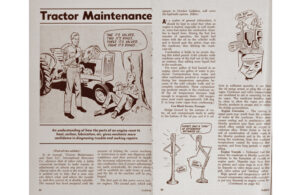The Golfdom Files: Tractor maintenance
The Golfdom staff tackled the basics of tractor maintenance in this September 1964 issue of the magazine. In the first of a two-part series, read about what we knew about tractor engine care in the ‘60s. Click here to read the full article — and see part two.
In its manual, “Tractor Maintenance and Tune Up,” International Harvester Co. observes that it takes only a fairly competent mechanic to make repairs or adjustments on almost any piece of machinery when the need or the trouble spot is pointed out to him. But a man who can detect what and where the trouble is, and then correct it, is doubly valuable. The manual has been prepared with the purpose of helping the course mechanic or serviceman to make any diagnosis with confidence and then proceed to handle the necessary adjustments or overhaul. It also emphasizes that if proper adjustments are made periodically, the tractor always will be avail- able for eight hours of work.

Photo: Golfdom staff
As a matter of general information, it should be kept in mind that when an engine is started, especially in cold weather, some fuel enters the combustion chamber in liquid form. During the first few minutes of operation, the liquid fuel mixes with the oil on the cylinder walls and is forced past the piston rings into the crank- case, thus diluting the crank case oil.
Combustion is liable to be erratic dur- ing this initial period. Cold cylinder walls condense some of the fuel out of the fuel- air mixture, thus adding more liquid fuel to the crankcase.
For every gallon of fuel burned in an engine, about one gallon of water is produced. Contamination from water and other combustion products is exaggerated during low-temperature operations because of the cold cylinder walls and incomplete combustion. These contaminating products remain in the crankcase until the oil temperature be- comes high enough to evaporate them. (Oil temperature must reach approximately 140 degrees F to keep water vapor from condensing.)
Can Block Screen, Passages
Sludge formed by the mixture of water, oil and contaminants tends to settle to the bottom of the oil pan, and if it collects in sufficient quantity, it can block the oil pump screen or plug the oil passages. Crankcase and valve compartments are ventilated to aid in removing the water vapor. The crankcase breather must be clean to allow the vapor and other blowby products to escape and to reduce the sludge accumulation.
Engine Corrosion — The rusting of metal parts may result from the presence of water in the crankcase. Water alone causes rusting and, in combination with blowby products, may form acids which attack other metals such as copper or cad- mium alloy. Water forms as the result of condensation of water vapor in the blowby products and in the air entering the crankcase, from low crankcase tempera- tures caused by worn-out thermostats, and from long periods of engine idling.
Engine Varnish — Unburned fuel that enters the crankcase in blowby gases contributes to the formation of varnish on engine parts. Deposits may then form on pistons and cause rings to stick. Simi- lar deposits on valve stems result in slug- gish valve action and “sticking” valves.
High speeds and temperatures and increased compression ratios with more power put new demands on engine valves.
<p>The post The Golfdom Files: Tractor maintenance first appeared on Golfdom.</p>

